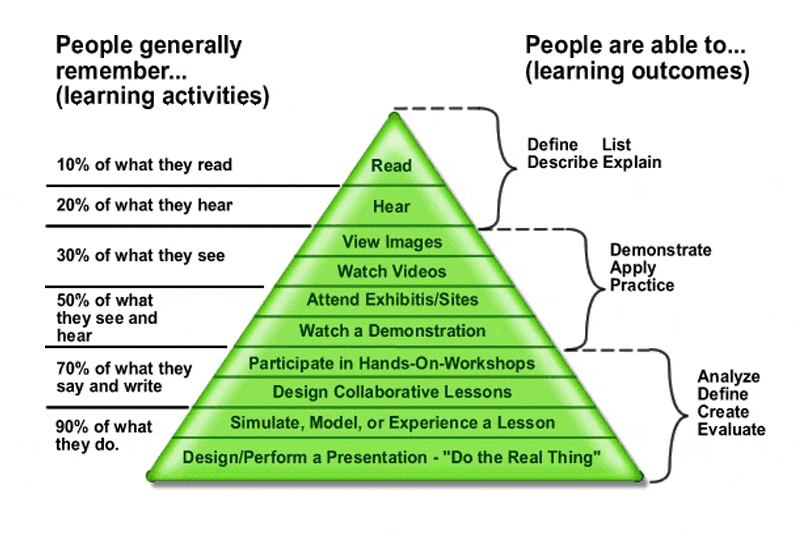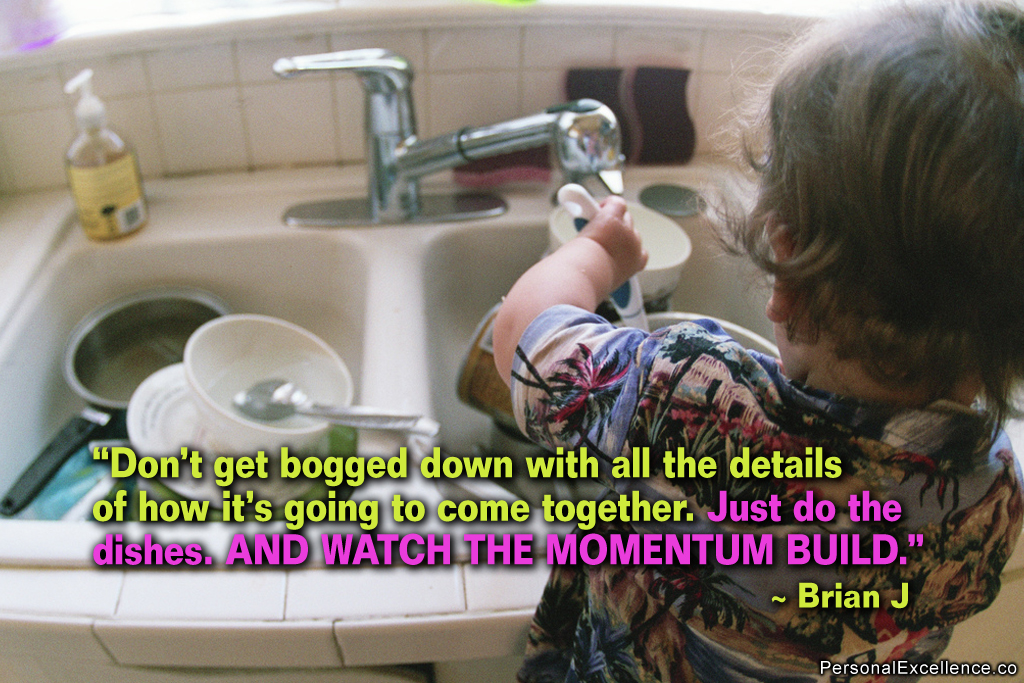
Do you want to learn faster than anyone else? Do you want to retain the key information from every book you read, every class you attend, every podcast you listen, and every conversation you are a part of?
How to Increase Your Learning Multifold
If you truly want to learn more and learn faster than anyone else, here’s one simple yet crucial learning hack I have for you:
When learning, instead of passive receiving the information like most people would, take on the role of an active learner.
That means, whenever you read a book/article, attend a class/course/workshop, listen to a podcast, or listen to a conversation…
- Share, engage, and discuss the material with other people. This is especially true if it’s a class or conversation.
- Identify the lessons from the content that is being shared.
- Create your action steps where you apply those lessons onto your life.
- Act on those steps, right away.
- Transit from being a learner to a teacher. Share what you have learned with others who were not part of the original learning experience. Enable them to apply those lessons.
Whatever it is, don’t just receive the information passively and do nothing about it—that’s no different than being a self-help junkie. Not only does the information not get retained, it gets lost as fast as the time you spent reading or listening to it. It’s almost like not having been exposed to the material to begin with.
My Learning Experience
Back when I was in university, I was on the Dean’s List every academic year. (The Dean’s List is an honorary roll for top students in the faculty. If you’re still studying, learn how you can get on the Dean’s List as well: How To Get on the Dean’s List (series))
To be honest, I didn’t study as hard as one might think is needed to get onto the Dean’s List. I barely studied when I was out of the school campus. I spent quite a large chunk of time playing games and being occupied with my core-curriculum activities, my graphic design business, and giving tuition to kids (I had three separate tutees then). When it came to exams, I would only start revision one to two weeks before, sometimes just a couple of days.
What was enabled me to score well then? Several factors, with an active approach towards learning being one of them. Each time I attended a class, I would read the required material and do the assignment beforehand. This way, I would pick up new insights from the professor during class rather than playing catch-up on ideas that were already in the textbook. When in class, I would participate actively, from taking down notes, to asking questions, to answering questions.
Because of my active learning approach, I retained much of the information that was taught; sometimes nearly 100% of it. I often got away with minimal, last minute revisions and would still be one of the top scorers at the end of the day. Active learning is clearly a 80/20 route (i.e. a highly effective route that helps me achieve great results with minimal effort).
Cone of Experience (often referred to as Cone of Learning)
I later came across this learning model by Edgar Dale, called “Cone of Experience” (it’s often wrongly referred to as “Cone of Learning”). (Edgar Dale (1900–1985) was an American educationist at Ohio State University.)
With the “Cone of Experience”, Dale attempted to illustrate the different extents to which people retain information after an activity, based on their method of learning. See below:

Here is the model translated into words:
- When you learn by only reading (such as reading a book or an article), you will remember only 10% of what you read.
- When you learn by only listening (such as listening to a podcast, a lecture, or a conversation), you will remember only 20% of what you hear.
- When you learn by only viewing images or watching videos, you will remember only 30% of what you see/hear.
- When you learn by attending exhibits or watching a demonstration, you will remember only 50% of what you see/hear.
- When you learn by participating in workshops (sharing what you know and being an active part of the discussion) or designing collaborative lessons (where you process what you learn and package it to help others), you will remember up to 70% of what you write/say.
- When you learn by simulating a lesson or performing a presentation (where you transit from being a learner to a teacher), you will remember a whooping 90% of what you do!
While these figures have since been disputed (they were not in Dale’s original model and were only added after he died), the fact remains that learning by active means (e.g. sharing, discussion, engagement, and application) enables someone to retain more information and understand more of the material than passive learning (e.g. reading, watching, or listening without attempting to assimilate the information).
Most Active Participants = Participants Who Gain The Most
For this same reason, I often encourage my course participants to participate actively. “Share your answers (to the exercises),” I always say. “Let me know what’s on your mind,” I always urge. “Ask me any questions you want,” I always iterate. These are things I say over and over again in every course I run, be it in Live a Better Life Program, Be a Better Me Program, or the most recent Emotional Eating Course.
I have found that my most active participants are often the ones who get the most breakthroughs and achieve the most results by the end of the course. I don’t think it’s a case of them wanting to learn any more than the other participants actually; I think everyone who (paid money and) signed up have an equal desire to learn and improve on the subject in question.
It’s just that:
- When these participants actively share their answers with everyone, they get to review their answers in the process and see those answers in a different light. This lets them refine their thoughts further.
- Sharing their answers allows them to receive feedback from other participants, which in turn opens them to perspectives they may have never considered. Blind spots get revealed and new learning opportunities are uncovered.
- Sharing their answers also means they get to receive feedback from me. As the person who designed the course and the exercises, it lets me know whether they are on the right track. I can then guide them accordingly, such that they get the maximum results from the course.
- Since every course is a combination of theory and participant sharing, when participants share, part of the course becomes centered around them. My coaching is naturally directed at these participants. (I can’t coach those who do not wish to share.) Other participants often build on these participants’ examples as well. This is especially true for small group coaching courses, which are heavily centered on discussion and application, than seminars, which are more content and theory-based.
If we take this discussion beyond just courses, you will find that the same trend applies.
- My most active one-to-one coaching clients, the ones who actively ask questions and are engaged during the coaching sessions, tend to achieve the most results after the sessions.
- The most active PE forum members, the ones who leverage on the forum platform to journal about their goals, benefit greatly because they become more accountable to their goals, not to mention the positive feedback and support they receive from other members.
- My most active readers, the ones who actively share their thoughts and experiences on the topics that relate to them, benefit from the sharing because they get to share their thoughts with an audience (which is a step towards leadership, believe it or not), work through their thoughts (hence gaining a new level of clarity), and at times receive useful opinions from other readers (sometimes myself too).
Stop Limiting Your Learning
Here is a question to ask yourself: Whenever you read an article, attend a course, listen to a podcast, or listen to a conversation, do you take the role of the passive receiver or do you take the role of an active learner?
Most people are passive receivers. Some people try to participate to some extent, but they are still passive receivers at the end of the day, because they fail to actively integrate the wealth of knowledge they have received with their lives. Very, very, few people (probably less than 0.1%) can claim to be active learners.
How active are you when it comes to learning? Have you been unknowingly limiting your learning? How can you start applying the five steps (highlighted at the start of the article), starting with this article, as you switch from the role of a passive receiver to an active learner?
(Images: Cass Sculpture Foundation, Wikipedia)







 Thanks for reading. If you like my free articles, join my private email list and get my latest updates and articles sent right to your inbox.
Thanks for reading. If you like my free articles, join my private email list and get my latest updates and articles sent right to your inbox.